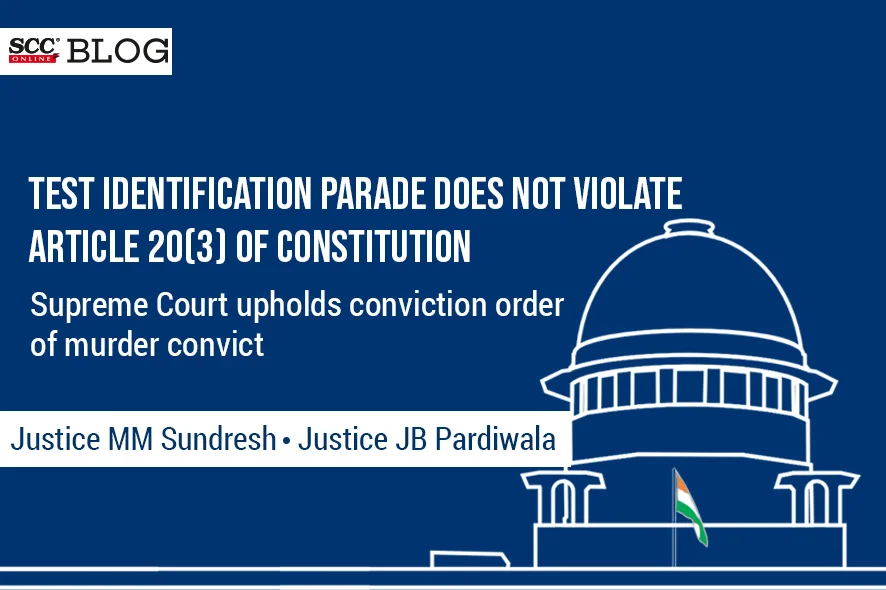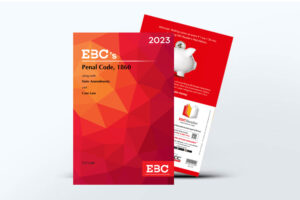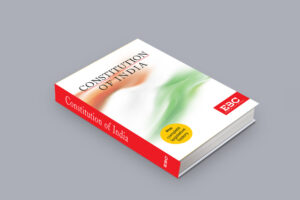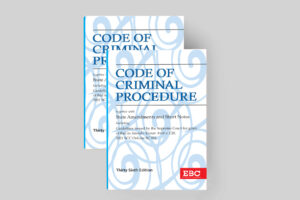Supreme Court: In an appeal filed by the convict against the judgment and order passed by the Delhi High Court, wherein the Court has affirmed the conviction order passed by the Additional Sessions Judge holding the convict guilty for the offences punishable under Sections 302, 392, 394 and 397 read with Section 34 of the Penal Code (for short, ‘IPC')., the division bench of MM Sundresh and JB Pardiwala*, JJ. while upholding the conviction order, held that Test Identification Parade (‘TIP') does not violate Article 20(3) of Constitution and the accused cannot refuse to join TIP.
During the investigation, the investigating officer decided to hold the TIP of the accused persons. However, it is the case of the prosecution that the convict declined to participate in the TIP on the ground that he was already shown to the witnesses in the police station. Further, after the arrest of the convict, he made a statement that he would be able to show the weapon of offence i.e., the ice pick which he had placed in one corner of his house. The investigating officer is said to have discovered the weapon of offence.
Whether TIP violates the fundamental right of an accused under Article 20(3) of the Constitution
The Court took note of Article 20(3) and said that it prohibits procuring of the positive volitional evidentiary acts of an accused by compulsion. Further after referring to It is true that an accused may be said to be compelled to attend a test identification parade, but this compulsion does not involve any positive volitional evidentiary act. His mere attendance or the exhibition of his body at a test identification parade, even though compelled, does not result in any evidentiary act until he is identified by some other agency. The identification of him by a witness is not his act, even though his body is exhibited for the purpose.
The Court said that TIP is part of investigation, and the investigation of a case is to be conducted by the investigating agency and it is their statutory prerogatives. There was no statutory provision authorizing the accused to pray for placing him in the test parade
What is the true purport of Section 54A of the Code of Criminal Procedure (‘CrPC'), 1973?
The Court after taking note of Section 54A of the CrPC, said that this Section empowers the court, on the request of the officer-in-charge of a police station, to direct for placing the accused at test identification parade for identification by any person or persons in such manner as the court may deem fit.
The Court viewed that after the introduction of Section 54A in the CrPC, an accused is under an obligation to stand for identification parade. An accused cannot resist subjecting himself to the TIP on the ground that he cannot be forced or coerced for the same. If the coercion is sought to be imposed in getting from accused evidence, which cannot be procured through positive volitional act on his part, the constitutional guarantee as enshrined under Article 20(3) of the Constitution will step in to protect him.
However, if that evidence can be procured without any positive volitional evidentiary act on the part of the accused, Article 20(3) of the Constitution will have no application. The accused, while subjecting himself to the TIP, does not produce any evidence or perform any evidentiary act. It may be a positive act and even a volitional act, but only to a limited extent, when the accused is brought to the place where the TIP is to be held. It is certainly not his evidentiary act. The accused concerned may have legitimate grounds to resist facing the TIP saying that the witnesses had a chance to see him either at the police station or in the Court however, on such ground alone he cannot refuse to face the TIP. It is always open for the accused to raise any legal ground available to him relating to the legitimacy of the TIP or the evidentiary value of the same during the trial. However, the accused cannot decline or refuse to join the TIP.
Importance and evidentiary value of TIP
The Court stated that facts which establish the identity of any person or thing whose identity is relevant are, by virtue of Section 9 of the Evidence Act, always relevant. The term ‘identification' means proving that a person, subject or article before the Court is the very same that he or it is alleged, charged or reputed to be. The identification has by itself no independent value.
As per the Court, during the investigation of a crime committed by persons unknown to the witnesses, the persons arrested on suspicion have got to be confronted by the investigating authority with the witnesses so that they can find out whether they are the persons who committed the crime or not. Before the investigating authorities send up a case to Court, they must be satisfied that the persons arrested by them are the persons accused of having committed the crime. If they were known to the witnesses, the witnesses would have given their names and that would have established their identity, but when they were not known, their identity could be established only if the witnesses on seeing them say that they are the offenders.
The Court reiterated that the substantive evidence is the evidence of identification in court and the test identification parade provides corroboration to the identification of the witness in court, if required. However, what weight must be attached to the evidence of identification in court, which is not preceded by a test identification parade, is a matter for the courts of fact to examine.
The Court noted that while the co-accused persons initially participated in the TIP, but thereafter all the accused persons including the convict refused to participate in the TIP. In their further statements recorded under Section 313 of the CrPC, all of them gave the explanation that they refused to participate as they had already been shown to the witnesses in the police station.
The Court further reiterated that a witness is trustworthy and reliable, the mere fact that no identification parade could be conducted, and the convict was identified for the first time before the Trial Court, would not be a reason to discard the evidence of the witness.
Placing reliance on Munna v. State (NCT of Delhi), (2003) 10 SCC 599 , wherein it was held that in a case where an accused himself refused to participate in the TIP, it is not open to him to contend that the statement of the eyewitnesses made for the first time in Court, wherein they specifically point towards him, should not be relied upon. Such a plea is available, provided the prosecution is itself responsible for not holding a TIP.
As per the Court, although the convict in his statement recorded under Section 313 CrPC stated that he had refused to participate in the TIP as the eyewitnesses had already seen him, yet except a bald assertion, no other foundation has been laid for offering such an explanation. It is true that the explanation that the accused may offer when the Court confronts him with the incriminating materials in his further statement has to be tested on preponderance of probability and not on proof beyond reasonable doubt. However, even while testing the answer on preponderance of probability some foundation has to be laid for such an explanation to be accepted. A mere bald assertion is not sufficient.
The Court further said that the statement of the convict relating to the weapon of offence is one additional circumstance pointing towards his guilt and at the same time lending credence to the substantive evidence of his identification by witness before the Trial Court, as even if the discovery statement made by the convict is not admissible under Section 27 of the Evidence Act, still it is relevant under Section 8 of the Evidence Act.
Thus, the Court, while upholding the conviction order, held that the prosecution has established its case against the convict beyond a reasonable doubt.
However, the convict is from a poor family and was undergoing sentence for more than sixteen years, the Court granted liberty to file a representation addressed to the competent authority of the State (NCT of Delhi) for premature release.
[Mukesh Singh v The State (NCT of Delhi), 2023 SCC OnLine SC 1061, Decided on 24-08-2023]
*Judgment Authored by: Justice JB Pardiwala
Know Thy Judge | Supreme Court of India: Justice J.B. Pardiwala









